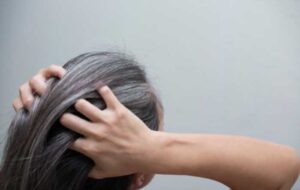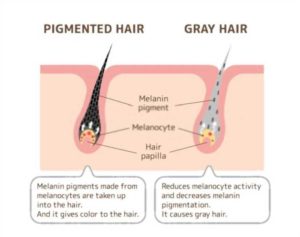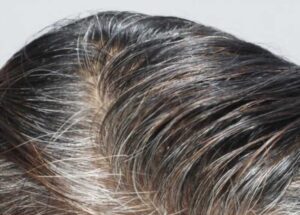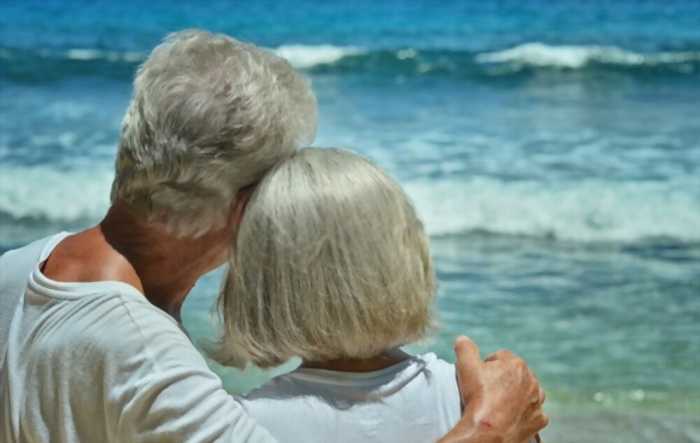Sooner or later, whether to a greater or lesser extent, we will all have to deal with greying hair. Like the other outward appearances that accompany ageing, we have two choices – fight it or embrace it. One thing is paramount: you cannot prevent turning grey. So, now that that’s out in the open, we can discuss how to wear the inevitable as beautifully as possible.

Did you know that about half of the population has already turned 50% grey before their 50th birthday? And that some people have to deal with it even at a relatively young age?
Premature greying or, conversely, at a later age, is mainly due to genetic factors. But lifestyle and nutrition also play a role. The first visible grey hairs, which are the result of a complex biological process, are received by most with mixed feelings. Because let’s face it: this especially confirms the fact that we really don’t have eternal youth!
The colour of your hair
 Hair is formed in hair follicles and provided with its colour by melanin (pigment). Melanin can be divided into two distinct types: eumelanin and pheomelanin. The latter is responsible for red hair, while due to an abundance of eumelanin, the hair will be black or brown and in smaller quantities will cause fair hair.
Hair is formed in hair follicles and provided with its colour by melanin (pigment). Melanin can be divided into two distinct types: eumelanin and pheomelanin. The latter is responsible for red hair, while due to an abundance of eumelanin, the hair will be black or brown and in smaller quantities will cause fair hair.
Over the course of your life, a natural colour change occurs: the hair first becomes darker, then grey, then white. The exact concentrations of eumelanin and pheomelanin are determined genetically. However, gene expression is not constant throughout your life – the shifts that take place cause changes in hair colour that may be experienced during childhood. Some children start life as a platinum blonde, but darken before they reach puberty. In children with dark hair, the colour usually stays the same.
 The colour change that takes place years later is the result of a gradual decrease in pigment, as less melanin is produced in the hair roots. More and more new hairs grow with less pigment. Once a hair root has produced hair without pigment, it will not grow coloured hair afterwards. Incidentally, the colour of existing hair does not change. After a hair falls out, it is replaced by a hair with less or no pigment.
The colour change that takes place years later is the result of a gradual decrease in pigment, as less melanin is produced in the hair roots. More and more new hairs grow with less pigment. Once a hair root has produced hair without pigment, it will not grow coloured hair afterwards. Incidentally, the colour of existing hair does not change. After a hair falls out, it is replaced by a hair with less or no pigment.
In addition to the reduced amount of melanin, the pigment in the hair also becomes paler with age. This is due to higher levels of hydrogen peroxide, a natural substance in the body, which affects the colour. Treatment against grey hair is therefore always aimed at stimulating the production of melanin and a decrease of hydrogen peroxide in the body.
Why do some turn grey prematurely?
The fact that one person turns grey around the age of thirty and another a few decades later is also genetically determined. Let’s just say it usually runs in families. By the age of 50, most people will have (partly) grey hair anyway. As mentioned before, a number of other factors also play their part.
Gray hair and stress
In general, it is safe to say that stress is never good for you. Both emotional and physical stress can cause premature grey hair. Avoiding stress as much as possible by following an active and healthy lifestyle, getting enough sleep and ensuring relaxation, not only contribute to a healthy and fit body, but also have beneficial effects on the health and colour of your hair.
There is evidence that stress speeds up the ageing process, and that psychological stress can indeed have an effect on your hair. Stress can cause hair loss, which generally grows back. However, stress can also cause your hair to turn grey prematurely.
We previously established that once hair turned grey, it will remain grey. For many, this may be a further motivation to prevent or reduce stress. In addition, it should be noted that higher amounts of pigment in the hair make it more sensitive to external influences. Hair rich in pigment has been found to be more sensitive to stress. Stress produces norepinephrine, which penetrates the hair roots. The production of melanin (by the stem cells present there) is disrupted by norepinephrine, and new hairs are formed without colour pigment.
Gray hair and nutrition
Pigment loss in the hair can be caused by a deficiency or lack of minerals and vitamins. A varied diet with a lot of protein, vitamins B12 and D3 and iron can have a beneficial effect on the health and colour of your hair.
 Vitamin B12
Vitamin B12
A substance that contributes to a beautiful hair colour. Vitamin B levels can also be negatively affected by stress. It would make sense to take vitamin B supplements to combat grey hair, however, remember that once you stop taking it, the greying process will continue.
This nutrient can be found in animal products such as eggs, meat, dairy and fish.
Iron, iodine, zinc and copper
These minerals are necessary for strong and healthy hair.
Iron can be found in a readily absorbable form in meat and fish, but can also be obtained from vegetables.
Iodine has been added to bread, but can also be obtained from fish and seaweed.
 Zinc is found in meat, fish, shellfish, cheese, nuts and grain products.
Zinc is found in meat, fish, shellfish, cheese, nuts and grain products.
Copper is found in vegetables, fruits, meat, grain products and cocoa products. Pigmented hair is richer in copper and zinc.
Like ageing, grey hair cannot be prevented. If you are not really pleased with the newly obtained grey strands, one option still remains: dyeing. But why not just embrace those charming grey hairs as an undeniable part of life? Since grey hair is often more brittle and fragile, using any aggressive products to colour the hair may not be the best choice.
One thing, though: grey hair needs special care.
A few tips for beautiful, well-groomed, grey hair
 Due to the lack of pigment, grey hair is light and tends to fade to a yellow or coppery colour. In its general care it is best to choose a silver shampoo, conditioner and a nourishing mask especially for grey hair. Gray hair often takes on a yellow glow. This is partly due to water, chlorine and sunlight. Washing your hair with a silver shampoo may help to prevent this – the blue-purple pigments neutralize the yellow tint. The result will be more intense if you leave it on for 2 to a maximum of 5 minutes before rinsing it.
Due to the lack of pigment, grey hair is light and tends to fade to a yellow or coppery colour. In its general care it is best to choose a silver shampoo, conditioner and a nourishing mask especially for grey hair. Gray hair often takes on a yellow glow. This is partly due to water, chlorine and sunlight. Washing your hair with a silver shampoo may help to prevent this – the blue-purple pigments neutralize the yellow tint. The result will be more intense if you leave it on for 2 to a maximum of 5 minutes before rinsing it.
The texture of grey hair can get a bit coarse. Special conditioners for grey hair can also neutralize the yellow colour, nourishes and makes the hair easy to comb, and it will remain smooth and shiny. Preferably let your hair air dry after washing and only comb it when it is dry to prevent it from breaking while it is still wet.
Treat your hair to a nourishing mask once a week for extra care.
Together with the natural colour change, you can also seize the opportunity to switch to a completely new “look”, a good hairdresser will undoubtedly be happy to advise you.
You may also want to review your make-up and clothing choice. After all, it is not only the colour of your hair that changes, the colour of your skin also changes with age.
Since grey hair can also turn yellow after heat treatment, it is recommended to keep the use of a hair dryer or curling iron to a minimum.
 Moisturizer for grey hair
Moisturizer for grey hair
Shea butter, aloe vera, argan oil, jojoba oil, and honey are among favourites.
Argan oil has a number of benefits attached to it. While it is largely used for treating dull, damaged, and grey hair, there are some other surprising benefits. This oil moisturizes deeply, it nourishes and conditions your hair, makes it shiny and soft, cuts down frizz, repairs hair cuticles, eliminates dandruff, treats brittle hair, and a dry and itchy scalp, promotes hair growth and curbs hair fall.
In addition, argan oil protects your hair from sun damage.
How do you use argan oil to treat grey hair?
Simply make your own conditioner with argan oil and apply it to your hair after washing.

